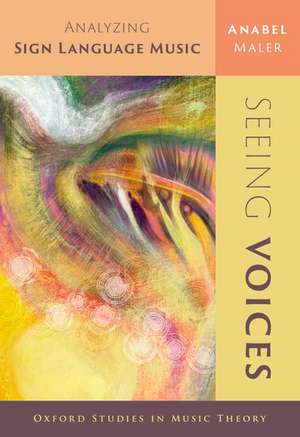Seeing Voices: Analyzing Sign Language Music: Oxford Studies in Music Theory
Autor Anabel Maleren Limba Engleză Paperback – 3 feb 2025
Din seria Oxford Studies in Music Theory
- 5%
 Preț: 276.87 lei
Preț: 276.87 lei -
 Preț: 221.07 lei
Preț: 221.07 lei - 9%
 Preț: 483.13 lei
Preț: 483.13 lei - 21%
 Preț: 368.05 lei
Preț: 368.05 lei - 12%
 Preț: 561.42 lei
Preț: 561.42 lei - 10%
 Preț: 437.84 lei
Preț: 437.84 lei - 13%
 Preț: 175.76 lei
Preț: 175.76 lei - 27%
 Preț: 372.14 lei
Preț: 372.14 lei - 28%
 Preț: 368.77 lei
Preț: 368.77 lei - 23%
 Preț: 372.55 lei
Preț: 372.55 lei -
 Preț: 340.37 lei
Preț: 340.37 lei - 14%
 Preț: 297.70 lei
Preț: 297.70 lei -
 Preț: 283.16 lei
Preț: 283.16 lei - 22%
 Preț: 328.95 lei
Preț: 328.95 lei - 12%
 Preț: 314.69 lei
Preț: 314.69 lei - 12%
 Preț: 291.71 lei
Preț: 291.71 lei - 12%
 Preț: 292.38 lei
Preț: 292.38 lei - 21%
 Preț: 349.04 lei
Preț: 349.04 lei - 22%
 Preț: 347.43 lei
Preț: 347.43 lei - 22%
 Preț: 327.26 lei
Preț: 327.26 lei -
 Preț: 352.55 lei
Preț: 352.55 lei -
 Preț: 257.59 lei
Preț: 257.59 lei - 6%
 Preț: 299.99 lei
Preț: 299.99 lei - 12%
 Preț: 323.95 lei
Preț: 323.95 lei - 9%
 Preț: 139.99 lei
Preț: 139.99 lei - 10%
 Preț: 468.75 lei
Preț: 468.75 lei - 12%
 Preț: 289.95 lei
Preț: 289.95 lei - 9%
 Preț: 476.52 lei
Preț: 476.52 lei - 25%
 Preț: 345.40 lei
Preț: 345.40 lei - 27%
 Preț: 449.20 lei
Preț: 449.20 lei
Preț: 134.84 lei
Preț vechi: 173.51 lei
-22% Nou
Puncte Express: 202
Preț estimativ în valută:
25.81€ • 26.84$ • 21.30£
25.81€ • 26.84$ • 21.30£
Carte disponibilă
Livrare economică 12-18 martie
Preluare comenzi: 021 569.72.76
Specificații
ISBN-13: 9780197601983
ISBN-10: 0197601987
Pagini: 256
Ilustrații: 28 music examples, 25 figures, 2 tables
Dimensiuni: 156 x 236 x 15 mm
Greutate: 0.38 kg
Editura: Oxford University Press
Colecția OUP USA
Seria Oxford Studies in Music Theory
Locul publicării:New York, United States
ISBN-10: 0197601987
Pagini: 256
Ilustrații: 28 music examples, 25 figures, 2 tables
Dimensiuni: 156 x 236 x 15 mm
Greutate: 0.38 kg
Editura: Oxford University Press
Colecția OUP USA
Seria Oxford Studies in Music Theory
Locul publicării:New York, United States
Recenzii
Maler's groundbreaking analysis redefines music by challenging modality chauvinism and reframing music as movement through a study of deaf musicking. In presenting provocative questions about the essence of music, she demonstrates how deaf perspectives enrich our understanding of human expression. Seeing Voices is an essential contribution to music theory, history, applied linguistics, and Deaf Studies.
Not long ago "language" meant "spoken language." That particular conceit ended with the recognition of complex signed languages. Now another truism has fallen, the notion that music is necessarily aural. With this insightful, beautifully written, and very important book, Maler puts the spotlight on ASL songs, deaf singers, and music without sound to challenge received truths and unexamined assumptions about the nature and possibilities of musical performance.
In the ongoing educational battles over diversity and inclusion, disabled people are often overlooked in our music academies, perhaps none more so than deaf persons. In Seeing Voices: Analyzing Sign Language Music, Maler unpacks the rich history of this music by centering the experiences of deaf persons and challenging readers to rethink how they analyze and interpret the most basic aspects of music and music making. A must read for all those committed to musical justice and belonging.
This book will make you think deeply about questions you thought you already knew the answer to. What is music? Against the traditional understanding of music as organized sound, Maler's magisterial study of sign language music shows that music is better understood as organized movement. That permits her to offer compelling analyses of music produced within the deaf community, using American Sign Language, to create undeniably musical melody, rhythm, meter, form, and meaning. Along the way, she elucidates and validates deaf ways of knowing music and creating distinctive and engaging visual and tactile forms of music-making.
Not long ago "language" meant "spoken language." That particular conceit ended with the recognition of complex signed languages. Now another truism has fallen, the notion that music is necessarily aural. With this insightful, beautifully written, and very important book, Maler puts the spotlight on ASL songs, deaf singers, and music without sound to challenge received truths and unexamined assumptions about the nature and possibilities of musical performance.
In the ongoing educational battles over diversity and inclusion, disabled people are often overlooked in our music academies, perhaps none more so than deaf persons. In Seeing Voices: Analyzing Sign Language Music, Maler unpacks the rich history of this music by centering the experiences of deaf persons and challenging readers to rethink how they analyze and interpret the most basic aspects of music and music making. A must read for all those committed to musical justice and belonging.
This book will make you think deeply about questions you thought you already knew the answer to. What is music? Against the traditional understanding of music as organized sound, Maler's magisterial study of sign language music shows that music is better understood as organized movement. That permits her to offer compelling analyses of music produced within the deaf community, using American Sign Language, to create undeniably musical melody, rhythm, meter, form, and meaning. Along the way, she elucidates and validates deaf ways of knowing music and creating distinctive and engaging visual and tactile forms of music-making.
Notă biografică
Anabel Maler is an Assistant Professor of Music Theory at the University of British Columbia. Her research on sign language, Deafness, disability, and music has appeared in journals such as Music Theory Online, Music Perception, and the Journal of the Society for American Music. Her co-authored publication, "Rhythmic Techniques in Deaf Hip Hop" received the 2021 Adam Krims award from the Society for Music Theory. She previously taught at the University of Iowa and Indiana University.
